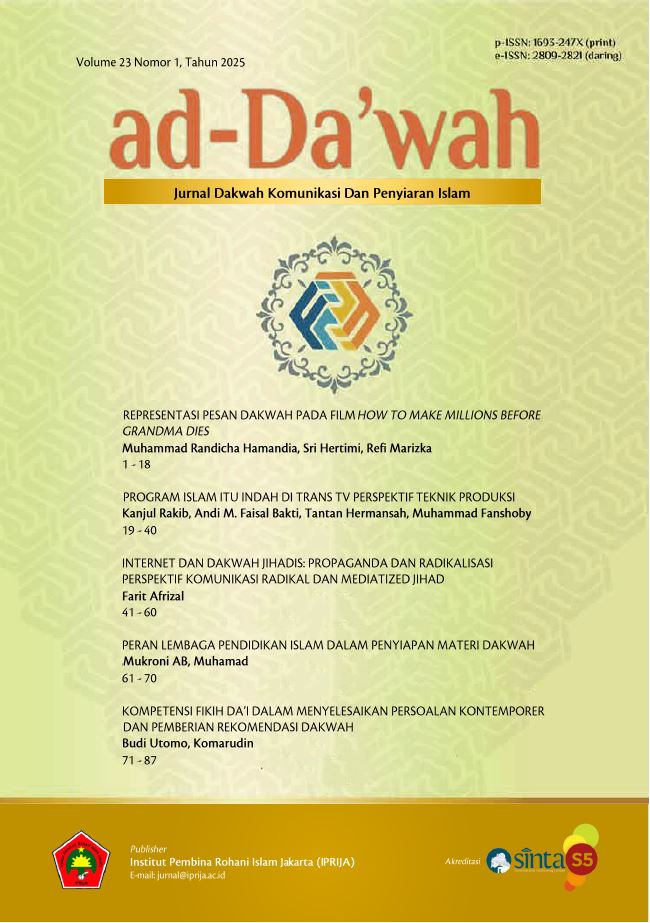Internet dan Dakwah Jihadis: Propaganda dan Radikalisasi
Perspektif Komunikasi Radikal dan Mediatized Jihad
DOI:
https://doi.org/10.59109/addawah.v23i1.125Kata Kunci:
Dakwah Jihadis, Propaganda, Radikalisasi daring, media sosial, internetAbstrak
Artikel ini bertujuan untuk mengkaji bagaimana kelompok jihadis memanfaatkan internet sebagai medium dakwah untuk menyebarkan propaganda, ideologi dan meradikalisasi individu. Secara teoritik, kajian ini mengacu pada teori komunikasi radikal dan mediatized jihad, yang menjelaskan hubungan antara teknologi digital dan penyebaran ideologi ekstrem. Menggunakan metode literature review dan melalui analisis tematik, artikel ini menunjukan bahwa kelompok seperti al-Qaeda dan Islamic State (IS) menggunakan berbagai platform digital seperti YouTube, Telegram, Twitter, dan situs web berlapis enkripsi serta mengembangkan platform digital sendiri untuk menyebarkan narasi jihad. Teknik yang digunakan meliputi storytelling visual, manipulasi simbol keagamaan, dan personalisasi pesan dakwah yang disesuaikan dengan target audien kalangan muda muslim urban. Segmentasi target meliputi pengguna internet usia produktif, pencari identitas religius, hingga simpatisan anti-Barat di berbagai negara. Artikel ini menyimpulkan bahwa strategi digital jihadis telah berkembang menjadi bentuk media warfare yang kompleks, menggabungkan propaganda visual, algoritma penyebaran, dan taktik psikologis.
Referensi
Al-Awlaki, Anwar. 44 Ways to Support Jihad. Victorious Media, n.d.
Aly, Anne, Stuart Macdonald, Lee Jarvis, and Thomas M. Chen. “Introduction to the Special Issue: Terrorist Online Propaganda and Radicalization.” Studies in Conflict & Terrorism 40, no. 1 (January 2, 2017): 1–9.
Behr, Ines Von, Anais Reding, Charlie Edwards, and Luke Gribbon. Radicalisation in the Digital Era: The Use of the Internet in 15 Cases of Terrorism and Extremism. Brussels: RAND Europe, 2013.
Bor, Stephanie, and Leila Chelbi. “The Internet.” In Communication Technology Update Dan Fundamentals. 16th ed. New York: Routledge, 2018.
Brandon, James. Virtual Caliphate. Islamic Extremists and Their Websites. London: Centre for Social Cohesion, 2008.
Carter, J.A, S Maher, and R Neumann. Measuring Importance and Influence in Syrian Foreign Fighter Networks. London: International Centre for the Study of Radicalisation and Political Violence, 2014.
Chrisafis, Angelique. “Violent Tide of Salafism Threatens Arab Spring.” Accessed July 29, 2023. https://gulfnews.com/world/mena/violent-tide-of-salafism-threatens-arab-spring-1.1146808#.
Dalgaard-Nielsen, Anja. “Violent Radicalization in Europe: What We Know and What We Do Not Know.” Studies in Conflict & Terrorism 33, no. 9 (August 16, 2010): 797–814.
Danish Security and Intelligence Service. Developments in the Threat from Foreign Fighters from Denmark in Syria. Copenhagen: Center for Terroranalyse, 2014.
Gendron, Angela. “The Call to Jihad: Charismatic Preachers and the Internet.” Studies in Conflict & Terrorism 40, no. 1 (January 2, 2017): 44–61.
General Intelligence and Security Service of the Netherlands. The Radical Dawa in Transition. (Zoetermeer: Algemene Inlichtingen-en Veiligheidsdienst, 2007.
Kaya, Ayhan. “Individualization and Institutionalization of Islam in Europe in the Age of Securitization.” Insight Turkey 12, no. 1 (2023).
Kohlmann, Evan. “A Beacon for Extremists: The Ansar al-Mujahideen Web Forum.” CTC Sintinel 3, no. 2 (2010).
Lia, Cf. Brynjar. Architect of Global Jihad. The Life of Al-Qaida Strategist Abu Musa’ab al Suri. London: Hurst & Co, 2007.
Lieberman, Joseph, and Susan Collins. Violent Islamist Extremism, the Internet, and the Homegrown Terrorist Threat. Washington: United States Senate Committee on Homeland Security and Governmental Affairs, 2008.
Lynch, Marc. “Al-Qaeda’s Media Strategies.” Center for the National Interest 83 (2006): 50–56.
Picken, Gavin. “The ‘Greater’ Jihad in Classical Islam.” In Twenty-First Century Jihad: Law, Society and Military Action,. London: I. B. Tauris, 2015.
Poot, C.J. de, and A. Sonnenscheins. Jihadi Terrorism in the Netherlands. The Hague: Boom juridische uitgevers, 2011.
Post, Jerrold. The Mind of the Terrorist: The Psychology of Terrorism from the IRA to Al Qaeda. Basingstoke: Palgrave Macmillan, 2007.
Post, Jerrold M., Cody McGinnis, and Kristen Moody. “The Changing Face of Terrorism in the 21st Century: The Communications Revolution and the Virtual Community of Hatred: The Changing Face of Terrorism in the 21st Century.” Behavioral Sciences & the Law 32, no. 3 (May 2014): 306–334.
Qardhawi, Yusuf. Ibn Al-Qarya Wa al-Kuttab: Malamih Sira Wa Masira. Vol. 1. Cairo: Dar al-Syuruq, 2002.
Quilliam Foundation. Radicalisation on British University Campuses: A Case Study. London: Quilliam Foundation, 2010.
Setiadi, Ahmad. “Pemanfaatan Media Sosial Untuk Efektifitas Komunikasi” (n.d.).
Shehabat, Ahmad, and Teodor Mitew. “Black-Boxing the Black Flag: Anonymous Sharing Platforms and ISIS Content Distribution Tactics” 12, no. 1 (2023).
Stern, Jessica, and J.M Berger. ISIS: The State of Terror. London: William Collins, 2015.
The Institute of Economics and Peace. Global Terrorism Index 2018. Sedney, 2018.
Torres, Manuel R., Javier Jordán, and Nicola Horsburgh. “Analysis and Evolution of the Global Jihadist Movement Propaganda.” Terrorism and Political Violence 18, no. 3 (September 2006): 399–421.
Watts, Clint. “Al-Qa`ida Versus the Islamic State.” CTC Sintinel 9, no. 7 (2016).
Weimann, Gabriel. “Cyber- Fatwas and Terrorism.” Studies in Conflict & Terrorism 34, no. 10 (October 2011): 765–781.
Weimann, Gabriel, and Katharina Von Knop. “Applying the Notion of Noise to Countering Online Terrorism.” Studies in Conflict & Terrorism 31, no. 10 (October 16, 2008): 883–902.
Unduhan
Diterbitkan
Cara Mengutip
Terbitan
Bagian
Lisensi
Hak Cipta (c) 2025 Farit Afrizal

Artikel ini berlisensiCreative Commons Attribution-NonCommercial-ShareAlike 4.0 International License.













